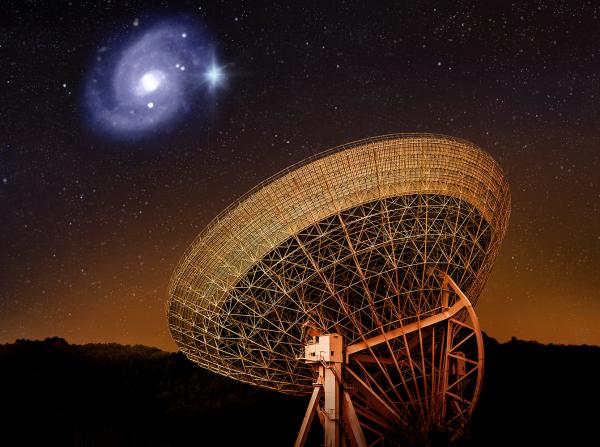
Two international teams of astronomers (with significant JIVE involvement) have narrowed-down the origin of the flashes produced in the famous fast radio burst FRB20180916B by examining them with the highest time resolution and at the lowest possible frequencies. These studies, published in Nature Astronomy and in The Astrophysical Journal Letters, point to the bursts being produced in a very tiny region close to the surface of a neutron star that is possibly orbiting a massive star, although new mysteries are also raised concerning these events.
In 2007, the first fast radio burst (FRB) was discovered. But what exactly causes the bursts is not yet clear. Since 2020, scientists have suspected a connection to strongly magnetic neutron stars, called magnetars. One of the best-known fast radio bursts is FRB20180916B. This FRB was discovered in 2018, but it was only last year when it was pinpointed to a spiral galaxy, thanks to observations with the European VLBI Network (EVN). This galaxy is similar to the Milky Way, and it is located "only" 500 million light years away from us. The FRB is the closest so far, and has a burst pattern that repeats every 16 days: 4 days of bursts, 12 days of relative quiet. That predictability makes it an ideal object for researchers to study.
Biggest detail ever
A team of researchers led by Kenzie Nimmo (ASTRON and University of Amsterdam) used these earlier observations with the European VLBI Network of radio telescopes, which includes one of ASTRON's 12 Westerbork telescopes in Drenthe and the 100-meter Effelsberg telescope in Germany to study the bursts with the highest possible time resolution. They looked in the greatest detail ever at the so-called polarized microstructure of the eruptions. The astronomers saw that the burst pattern of FRB20180916B varied from microsecond to microsecond. The most logical explanation for the variation seems to be a "dancing" magnetosphere enveloping a neutron star.
When the telescopes of the European VLBI Network observe the sky, they send the data to the Joint Institute for VLBI ERIC (JIVE; The Netherlands), where they are combined. "The key software in this process is the EVN Software Correlator (SFXC), various enhancements made to this software over the years have allowed the astronomers to look at the bursts with a time resolution that was not possible to be achieved previously", explained Aard Keimpema (JIVE), co-author of this research.
Lowest radio signals ever
In parallel, an international team of researchers led by Ziggy Pleunis (a graduate of the University of Amsterdam, now McGill University, Montreal, Canada) studied the FRB with the European network of LOFAR radio telescopes at the low frequencies the telescope can receive (110 to 188 MHz). They caught 18 bursts from FRB20180916B, which breaks the low-frequency record. Incidentally, the researchers suspect that the burst emits radiation in even lower frequencies and will be looking for that in the near future.
Besides records, the observations also provide new insights. The low-level radio emission was quite 'clean' and arrived later than bursts at higher radio frequencies. Co-author Jason Hessels (ASTRON and University of Amsterdam): "At different times we see radio bursts with different radio frequencies. Possibly the FRB is part of a binary star. If so, we would have a different view at different times of where these enormously powerful bursts are generated."
Scientific papers
Highly polarized microstructure from the repeating FRB 20180916B. By: K. Nimmo et al. In: Nature Astronomy, 22 March 2021.
Original: https://dx.doi.org/10.1038/s41550-021-01321-3
Free preprint: https://arxiv.org/abs/2010.05800
LOFAR Detection of 110-188 MHz Emission and Frequency-Dependent Activity from FRB 20180916B. By: Z. Pleunis et al. Accepted for publication The Astrophysical Journal Letters, 2021.
Original: https://iopscience.iop.org/journal/2041-8205
Free preprint: https://arxiv.org/abs/2012.08372
Image: Artistic view of the Effelsberg telescope pointing its dish at the galaxy 500 million light-years from Earth where the famous fast radio burst FRB20180916B sends out bursts of flashes with regularity. (c) Daniëlle Futselaar/ASTRON/HST
Video:
Video from early 2020 when scientists discovered that FRB20180916B must be at 'only' 500 million light years away from us. https://youtu.be/eKo-Jx3l418
